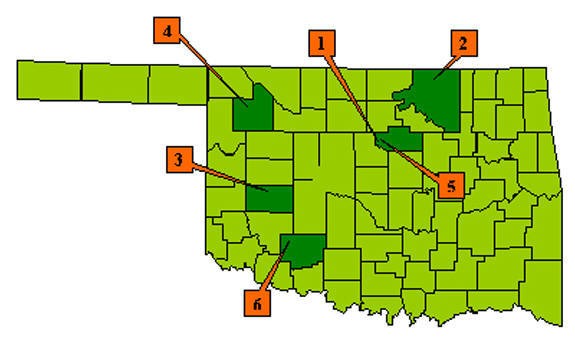Patch Burning Research & Demonstration Areas
OSU NREM Patch Burning Research
OSU Research Range (1)
Location: Payne County, 8 miles west and 2.5 miles south of Stillwater, OK
Land Owner: Oklahoma State University
Date Initiated: 1999
Plots: 6, 160 acre units
Treatments: 3 units - grazed, burned every three years; 3 units - grazed, patch burned (6 patches) spring and summer every year
Grazing Animal: Stocker cattle 1999-2001, cow/calf 2001-present
Publications From Area
- Cummings, D.C., S.D. Fuhlendorf, and D.M. Engle. 2007. Is altering grazing selectivity of invasive forage species with patch burning more effective than herbicide treatments? Rangeland Ecology and Management 60:253-260
- Fuhlendorf, S.D. and D.M. Engle. 2001. Restoring heterogeneity on rangelands: ecosystem management based on evolutionary grazing patterns. Bioscience 51:625-632
- Fuhlendorf, S.D. and D.M. Engle. 2004. Application of the fire-grazing interaction to restore a shifting mosaic on tallgrass prairie. Journal of Applied Ecology. 41:604-614
- Townsend II, D.E. 2004. Ecological heterogeneity: evaluating small mammal communities, soil surface temperature and artificial nest success within grassland ecosystems. Ph.D. dissertation, Oklahoma State University, Stillwater, OK.
- Tunnell, T.R. 2002. Effects of Patch Burning on Livestock Performance and Wildlife Habitat on Oklahoma Rangelands. M.S. Thesis, Oklahoma State University, Stillwater, OK.
Tallgrass Prairie Preserve (2)
Location: Osage County, 8 miles north of Pawhuska, OK
Land Owner: The Nature Conservancy
Date Initiated: 1993
Plots:
Treatments:
Grazing Animal: Bison in bison unit, stocker cattle in cattle units
Publications From Area
- Anderson, R.H. and Fuhlendorf, S.D. and Engle, D.M. 2006. Soil N availability in tallgrass prairie under the fire - grazing interaction. Rangeland Ecology and Management 59:625-631
- Fuhlendorf, S.D. and D.M. Engle. 2001. Restoring heterogeneity on rangelands: ecosystem management based on evolutionary grazing patterns. Bioscience 51: 625-632
- Fuhlendorf, S.D. and D.M. Engle. 2004. Application of the fire-grazing interaction to restore a shifting mosaic on tallgrass prairie. Journal of Applied Ecology. 41:604-614
- Fuhlendorf, S.S., W.C. Harrell, D.M. Engle, R.G. Hamilton, C.A. Davis, and D.M. Leslie Jr. 2006. Should heterogeneity be the basis for conservation? Grassland bird response to fire and grazing. Ecological Applications. 16 (5) 1706-1716
Marvin Klemme Range Research Station (3)
Location: Washita County, 10 miles south and 5 miles west of Clinton, OK
Land Owner: Oklahoma State University
Date Initiated: 1999
Plots: 4, 120 acre units
Treatments: 2 units - grazed and no burn; 2 units - grazed and patch burned (4 patches) every year in the spring
Grazing Animal: Stocker cattle
Publications from Area
- Fuhlendorf, S.D. and D.M. Engle. 2001. Restoring heterogeneity on rangelands: ecosystem management based on evolutionary grazing patterns. Bioscience 51: 625-632
Cooper Wildlife Management Area (4)
Location: Woodward County, 4 miles south of Ft. Supply, OK
Land Owner: Oklahoma Department of Wildlife Conservation
Date Initiated: 1999-2002 and 2005-present
Plots:
- 1999-2002 - 24 10 acre (4-ha) patches
- 2005-present - 3 pastures
1999-2000 Treatments:
4 pastures with 6 10-acre (4ha) patches
- 2 patches burned fall
- 2 patches burned spring
- 2 patches unburned
2005-Present Treatments:
- 3 pastures with approximately 1/3 burned each spring
Grazing Animal: Stocker cattle
Publications from this Area
- Vermeire, L.T., R.B. Mitchell, and S.D. Fuhlendorf. 2000. Sand sagebrush response to fall and spring prescribed burns. In: McArthur, E. Durant; Fairbanks, Daniel J., Proceedings: Shrubland Ecosystem Genetics and Biodiversity; 2000 June 13-15; Provo, UT. Proceedings: RMRS-P-000.
- Ogden, UT; Department of Agriculture, Forest Service, Rocky Mountain Research Station.
Vermeire, L.T. 2002. The fire ecology of sand sagebrush-mixed prairie in the southern Great Plains. Ph.D. thesis. Texas Tech Univ., Lubbock. - Vermeire, L.T., R.B. Mitchell, S.D. Fuhlendorf and R.L. Gillen. 2004. Patch Burning Effects on Grazing Distribution. Journal of Range Management 57:248-252
- Vermeire, L.T., D.B. Wester, R.B. Mitchell, and S.D. Fuhlendorf. 2005. Fire and grazing effects on wind erosion, soil water content, and soil temperature. Journal of Environmental Quality 34:1559-1565
Cross Timbers Experimental Range (5)
Location: Payne County, 7 miles west, 2 miles south, 1 mile east of Stillwater, OK
Land Owner: Oklahoma State University
Date Initiated: 2007
Plots: 1, 1760 acre unit
Treatments: 18 patches
- 3 - spring burn every 2 years
- 3 - spring burn every 3 years
- 3 - spring burn every 5 years
- 3 - summer burn every 2 years
- 3 - summer burn every 3 years
- 3 - summer burn every 5 years
Grazing Animal: Cow/Calf
Wichita Mountains Wildlife Refuge (6)
Location: Comanche County, 25 miles northwest of Lawton
Land Owner: U.S. Fish & Wildlife Service, US Department of Interior
Date Initiated: 2006
Grazing Animal: Bison, Elk and Longhorn Cattle

